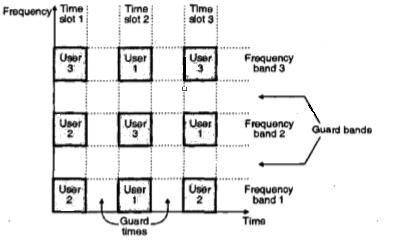Static Channelization in Medium Sharing Technique Of DLL
In the previous post, we have seen the dynamic medium sharing methods in detail. Now we shall explore the static channelization methods in DLL (data link layer). Channelization is basically a multiple-access method in which the available bandwidth of a link is shared in time, frequency, or through code, between different stations.
Depending on the method of sharing there are three channelization techniques :
- FDMA : Frequency Division Multiple Access
- TDMA : Time Division Multiple Access
- CDMA: Code Division Multiple Access
Application of each of these (in greater detail) we will discuss in the cellular network post later. Let us understand each one of this one by one :
Frequency Division Multiple Access (FDMA) in Static Channelization of DLL
In the frequency division multiple access (FDMA), the available channel (medium) bandwidth is shared by all the stations. That means each station will have its own specific slot reserved in the entire channel bandwidth.
The available bandwidth is divided into frequency bands. Each station is allocated a band to send its data. Each station also uses a bandpass filter to confine the transmitter frequencies.
To prevent station interferences , the allocated bands are separated from one another by small guard bands.Guard bands are provided between the adjacent frequency slots. Guard bands avoid adjacent channel interference.

The power required for transmission depends on the number of channels being transmitted. No synchronization is required between the channels.
FDMA is an access method in the data link layer. The data link layer in each station informs its physical layer to make a bandpass signal from the data passed to it.
Time Division Multiple Access (TDMA) in Static Channelization of DLL
In TDMA, the entire bandwidth can be used by every user (station) but not simultaneously. A station can use the entire bandwidth only for the allocated time slot.
Thus each channel is allocated a time slot only during which it can send its data. Thus the time is shared, the frequency band is not shared. Each station transmits its data in is assigned time slot.
The main problem with TDMA is to achieve synchronization between the different stations. In TDMA, the bandwidth is just one channel, TDMA needs synchronization which makes it more complicated as compared to FDMA.

TDMA is an access method in the data link layer (dll). The data link layer in each station first tells its physical layer to use the allocated time slot. TDMA is a data link layer (dll) protocol that uses TDM (time-division multiplexing) at the physical layer.
Code Division Multiple Access (CDMA) in Static Channelization of DLL
An alternative to FDMA and TDMA is another system called code division multiple access (CDMA). It differs from FDMA because only one channel occupies the entire bandwidth of the link. It differs from TDMA because all stations can send data simultaneously, there is no timesharing.
In CDMA each user is given a unique code sequence or signature sequence. This sequence allows the user to spread the information signal across the assigned frequency band.

CDMA is based on coding theory. Each station will be assigned a code, which is a sequence of numbers called chips. In CDMA the users access the channel in a random manner. The CDMA signals are spread in frequency.
At the receiver, the signal is then recovered by using the same code sequence. At the receiver, the signals received from various users are separated by checking the cross-correlation of the received signal with each possible user signature sequence.
In CDMA as the bandwidth as well as the time of the channel is being shared by the users, it is necessary to introduce the guard times and guard bands.
CDMA does not need any synchronization, but the code sequences or signature waveforms are required to be used.

Aric is a tech enthusiast , who love to write about the tech related products and ‘How To’ blogs . IT Engineer by profession , right now working in the Automation field in a Software product company . The other hobbies includes singing , trekking and writing blogs .




